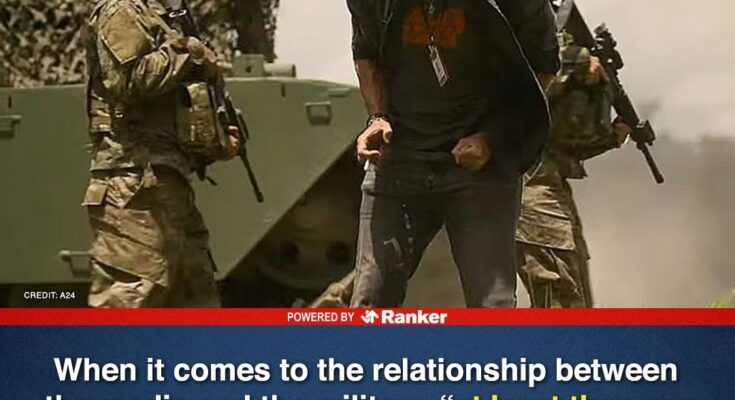Writers have been documenting war for centuries. Herodotus, Thucydides, and other ancient historians may or may not have been in the heat of battle, but they did relay information about conflicts through the written word. Sketches and paintings of war throughout history were also produced by combatants and observers during and after battle.
Modern war reporting didn’t come to fruition until the Crimean War. One of the first modern war correspondents, William Howard Russell, was present at the Battle of Balaklava on October 25, 1855, and his account influenced Alfred Lord Tennyson’s poem about the British blunder, The Charge of the Light Brigade. The Crimean War was also when photojournalism got its start, with photos from the likes of Roger Fenton, Felice Beato, and others capturing images of war in real time.
During World War I and World War II, much of the information about war activities made its way to the public through military and government channels. The Vietnam War, however, featured relatively few restrictions on war correspondents. This has been criticized (unfairly, in the eyes of many) for being dangerous, for swaying public opinion against the war, and for essentially leading to limited access for journalists during conflicts in the 1980s and 1990s.
By the early 2000s, war correspondents and photographers found a new position on the battlefield. Cooperation between the media and the military benefited both parties and brought information to the masses. Here are some specifics of how news outlets function in a time of war, what they can and can’t do, and how reporters and photographers live (and sometimes die) on the job.
To be a journalist in the middle of a war zone is intense. Moments of pure panic combined with exhilaration and awe for reporters and photographers determined to tell the story of what’s unfolding before their eyes.
Movies and television have offered their versions of war journalism from various vantage points. Whether it’s the rawness of 2024’s Civil War starring Kirstin Dunst, the fearlessness of A Private War (2018) with Rosamund Pike, or Whiskey Tango Foxtrot’s comedic slant on war, audiences have seen various takes on what it’s really like to be in the heat of battle as a journalist.
Here’s what it’s actually like to be a war photographer, reporter, or media worker, according to people who’ve been there.
-
Embedded Media Follows Rules Established By The Military
Interaction among journalists and the military is a necessary aspect of how war reporting happens. Embedded journalists and photographers don’t just report on battles from outside of the action but are attached to specific military units.
The presence of journalists alongside military personnel became commonplace during the US invasion of Iraq in 2003. In many ways, this was a reaction to the constant attention paid to the first Gulf War in 1991, albeit with limited direct coverage by journalists. When the United States invaded Iraq in 2003, nearly 800 journalists were there – all of whom agreed to follow rules established by the Pentagon.
Embedded members of the media were allowed to talk to military personnel after missions were complete and through proper command channels. Information that could not be released included specific numbers of troops and aircraft, numbers regarding equipment and supplies, and “Names of military installations or specific geographic locations of military units.” For photography, specifically, nothing that revealed security levels at military installations or camps could go public.
In 2008, the Department of Defense provided information about rules for embedded reporters to the Federation of American Scientists and specified that “there is no non-disclosure agreement for access to classified material for embedded reporters.” The rules went on to clarify that, while nothing would be confiscated by the military,
If it is believed that classified information has been compromised and the media representative refuses to remove that information… [officials will be notified] as soon as possible so the issue may be addressed with the media organization’s management.
-
Embedded Journalists Get A Unit Assignment From The Military
The military assigns journalists to specific units and “they eat, sleep, and move” with that group. Because journalists are generally civilians, they are protected as such. This means journalists have no special position or favor in a war zone, but they are not allowed to take part in hostilities in any way. Additionally, if a journalist is taken captive, they are then regarded as a POW. As a result,
They must be issued identification cards so that they may establish their entitlement to POW status upon falling into the power of the enemy during international armed conflict.
Reporters and photographers don’t get a choice of where they are placed but they do have decisions to make on the ground. Without a doubt, this includes potential risk-taking action. The Department of Defense makes it clear that any “journalists who enter areas of military operations assume a significant risk that they could be injured or killed incidental to an enemy attack or from other dangers,” meaning that neither the government nor the military is responsible for any potential harm.
-
Unilateral Journalists Operate On Their Own In A War Zone
Not all war correspondents are embedded. Unilateral journalists travel on their own, often interacting with civilians more than their embedded counterparts. Unilaterals have the same protections as embedded war journalists but don’t always have access to military information. That said, unilaterals often get more of the insight into the humanity of war.
There are benefits to being embedded, as war photographer Chris Hondros noted when talking about his experiences in Iraq in 2005. While on patrol with US troops, he was able “to get some really candid shots of Iraqi culture” from inside the protection of military vehicles.
There are also possible risks to not being embedded. In 2003, the International Federation of Journalists claimed that the US military “targeted” non-embedded journalists at the offices of Al Jazeera:
The bombing of hotels where journalists are staying and targeting of Arab media are particularly shocking events in a war which is being fought in the name of democracy. Those who are responsible must be brought to justice.
Officials from the US insisted the bombing was a “grave mistake.”
Being embedded is only an option for American reporters where US troops are on the ground. There were no US forces in Ukraine when the Washington Post reporter Lizzie Johnson arrived in late 2023, meaning she was on her own. Johnson had been through hostile-environment training when she arrived and received information from the Washington Post’s security team. Once in Kyiv, Johnson was accompanied by a translator, a security guard, and a photographer.
-
Embedded Reporters Learn A Lot About The Military As Well As Their Surroundings
After Luke Heikkila was embedded with US troops in Afghanistan in 2012, he described what it was like:
I traveled with soldiers, I ate with soldiers, I slept in the same barracks as soldiers. I was, for all intents and purposes, a journalist living with soldiers. I was commonly referred to as a “plus one.”
Ann Jones, embedded with US Army troops in 2006, found that she was,
Swamped by complaints from soldiers and civilian contractors alike: not enough armor, not enough vehicles, not enough helicopters, not enough weapons, not enough troops – and even when there seemed to be plenty of everything, complaints that nothing was of quite the right kind… [The complaints] seemed to spring from the very nature of the American military enterprise – from its toxic mix of paranoia, entitlement, and good intentions.
Jones also learned that many of the soldiers lived better in the military than they did before joining. What Hiekkila took away from his experience as much as anything was how lucky Americans are to not have to struggle just for a small amount of water.
-
The Relationship Between War Journalists And The Military Can Be Challenging
The media and the military have different objectives in a war zone, something that can lead to tension between the two. An inherent distrust of the media on the part of military personnel wasn’t helped by Geraldo Rivera exposing sensitive information about operations in Iraq in 2003 or Brian WIlliams’s exaggeration of his own experiences that same year.
Members of the military have described war journalists as too concerned with “selling newspapers, air-time, social media space” and not interested in “reporting the facts and realities surrounding conflict.” Other comments about reporters and photographers indicate soldiers view them as portraying “whatever gets the most viewers and gets the most money.” One more description from a combat veteran put it this way:
At least they are reliably manipulative and oversimplifying, so you don’t have to wonder if they’re being manipulative and oversimplifying.
Reporters, for their part, indicated in a survey from 2007 that the biggest limitations they faced while embedded were military restrictions on their access, reporting, and interviewing opportunities. As one reporter put it,
You go where they want you to go, embed with whom they allow you to embed. And they do always “spin” (or the officers do). Advantages are it’s the best or only way to reach ‘real’ Iraqis in their homes.
The country a war journalist comes from may play a part in how they’re treated, too. During the Iraq war, Arnim Stauth from the German media was not welcomed by British or American troops:
Clearly journalists were either privileged or discriminated against depending on the stance their government’s took towards the war. We were treated as though we were the right hand of the government.
Reporters and photographers embedded with military units may face harsh treatment but this isn’t insurmountable. Alex Quade, for example, was embedded with Colonel Robert L. Howard’s unit during the 1990s – a man known for his dislike of reporters. Howard expected Quade to do the same physical training as the troops and to “carry your own load” at all times. Howard’s reminders that she “never be quick to take the next step without knowing where it leads you” and “keep your eyes up and your butt down” ultimately kept her alive – and she was forever grateful.
-
War Correspondents Have To Trust Their Colleagues And Be Willing To Take Risks
Covering the war in Ukraine was never something Fox News war correspondent Benjamin Hall questioned. According to Hall, going “was a decision I made quickly.” And, even after nearly dying in Ukraine, he “never had a moment of regret making that decision to go.”
In March 2022, Hall was with colleagues Ukranian journalist Oleksandra “Sasha” Kuvshynova and cameraman Pierre Zakrzewski, when their car was hit by a bomb. Hall was the lone survivor although he was badly burned, lost one leg and a foot, and can no longer see out of one eye. Hall said about his experience in a conflict-torn area,
You can only work in those parts of the world if you totally, 100% trust each other and we developed a relationship that was incredibly deep. You have conversations you might not have with anyone else.
For Motaz Axaiza, taking risks was just the first part of covering the war between Israel and Hamas in 2023 and 2024. In his words, “the phase of trying to survive” started as the death toll rose around him. Shortages, continued bombings, and limited access to electricity have led another journalist in the region, Gazan Bisan Owda, to acknowledge she “no longer [has] any hope of survival.”
-
No Amount Of Protective Gear Can Keep War Reporters And Photographers Safe
Members of the press were, according to the Department of Defense in 2008, “responsible for procuring [and] using” protective equipment like helmets and vests. Clothing and protective gear were supposed to “be subdued in color and appearance.”
Most war correspondents and photographers wear or carry protective equipment. This can include body armor, helmets, and hazmat suits. War journalists can also take part in security training before going into the field.
Even with all of the training and protection available, war correspondents and photographers aren’t necessarily safe. Al Jazeera reporter Shireen Abu Akleh was killed in the West Bank in 2022, shot while “wearing a press vest and was standing with other journalists when she was killed.” Another journalist who was nearby when it happened told Al Jazeera:
We were four journalists, we were all wearing vests, all wearing helmets… The [Israeli] occupation army did not stop firing even after she collapsed. I couldn’t even extend my arm to pull her because of the shots being fired. The army was adamant on shooting to kill.
In November 2023, TV correspondent Salman al-Bashir showed his grief over the loss of life among journalists and other civilians in Gaza while on air. As he took off his flak jacket, removed his helmet, and threw them to the ground, he said,
These protection jackets and helmets don’t protect us… Nothing protects journalists… We lose our lives for no reason.
-
War Journalists See Horror And Joy Alike
Photojournalist Nicole Tung covered the Libyan uprising in 2011, during which found herself in situations “I wouldn’t put myself in anymore.” Tung saw two of her colleagues die during her time in the region and saw “a lot of crazy, gory, and very sad moments.” There was also, in her words, “a lot of joy” and even a “euphoric feeling” at times.
Tung described one image that has stuck with her:
A photograph of a boy in a chair… The person in the bodybag at his feet was his father. It was after a bomb attack on their home. His father had gone, and he didn’t quite understand that. It was just so fresh and so raw. But that look on his face – he wasn’t even crying, and that’s hard to witness.
Tung also talked about how she deals with those experiences:
You have to take care of your head and your heart… When you ignore that after witnessing terrible things, that’s when you start to lose sympathy, or empathy, for the people and the issues you are covering.
-
A Lot Of War Journalists Are Freelancers
Freelance journalists, especially inexperienced ones, may not make much money for their work. As a result, they may not be able to afford protective equipment and training to keep them safe.
The independent nature of war correspondents has been exacerbated since news organizations increasingly shut down foreign bureaus to cover wars. During the 1980s, journalist Chris Hedges worked for several newspapers but, as of 2014, worked on his own. Max Becherer, a war photographer, lamented the situation, noting the proliferation of freelancers:
People will try to just take your imagery and buy it for nothing. People will try to put you on assignment for very little… The regular news organizations don’t really have the money to cover it like they did… And freelancers can fill the gap, but it’s a lot of risks taken on by the freelancers.
Even the war reporters and photographers who aren’t freelancers may have to cover some of their own expenses. Since freelancers make anywhere from $50 to “several hundred” dollars for photos and stories, this doesn’t allow for extraneous expenses. Additionally, war correspondents without the full backing of a news organization may not have “mechanisms to put pressure” on any entity that might take them hostage.
Given the dependence upon freelancers, the number of full-time war correspondents has declined. For the sake of comparison and context, the US Bureau of Labor Statistics indicated news analysts, reporters, and journalists had median salaries of just under $56,000 in May 2022.
-
Fellow War Correspondents Are Both Friends And Competitors
Many war correspondents, photographers, and video journalists work as freelancers. Freelancers contract with media sites, but a lack of experience can lead to added vulnerability. Inexperienced war journalists are, however, much cheaper than those with more established backgrounds.
Freelance journalists like Laura Kasinof worked with The New York Times during the Arab Spring in Yemen and, while she was well-compensated, she found herself leaning on fellow journalists instead of her employer for advice:
I remember these stories of Libya, of these old war correspondents coming in and giving advice… and we didn’t have that. I had no experience with conflict so I didn’t really have experience on how to get close to it… I was young and I was with a lot of young journalists, and we all got closer than we should have… I don’t think the editors knew the extent to which my safety was compromised.
Competition for a story or photo in an ongoing conflict exists among war correspondents, but so does cooperation and collaboration. That said, it may be as much about any news organization backing a journalist competing with its rivals as any contest among the individuals themselves. Regardless, getting to a story first can boost one’s career while simultaneously heightening the quality of how information is reported to the masses.
-
Food, Lodging, And Other ‘Creature Comforts’ Might Be Hard To Find
In the middle of a war zone, journalists may have limited options for food, shelter, and electricity. Embedded war correspondents and photographers eat and sleep with their military units, but unilaterals may need to find resources elsewhere.
Experienced foreign correspondents stress the importance of building relationships with locals. This facilitates trust and leads to information. Richard Engel from NBC emphasized the use of local knowledge to “find a local fixer, local contacts, and a guide to help you on the roads.”
When reporter Olivia Ward from the Toronto Star found herself during the 1990s in Iraq in need of a place to stay, she was driven to a hotel with dim lights and dusty carpets. In contrast, many war correspondents in Ukraine in 2023 stayed at hotels repurposed for their presence. Those hotels function as bases of operation, albeit with limited access to resources and an uneasy proximity to danger. After Israeli airstrikes took place near the al-Deira Hotel in Gaza City where numerous war correspondents were staying in 2014, the building was evacuated.
Not all war correspondents stay at a hotel. Ukrainian reporter Ruslan Smieshchuk and his cameraman rent an apartment where they have “electricity, water, internet, a shower, a bathroom, and an electric stove.” Based in Eastern Ukraine, the apartment is a base of operation and where they sleep, eat, and relax.
-
Death Among Journalists And Media Workers Is On The Rise
The International Federation of Journalists reported in 2020 that 2,658 journalists had been killed in areas experiencing “war violence, crime, and corruption.” The group identified 2006 and 2007 as the years with the highest number of deaths (155 and 135, respectively.)
While the number of journalists killed in 2023 was 65, much lower than the previous year, the United Nations noted that a high number of deaths occurred in conflict zones. The deadliness of areas in conflict has been especially seen among journalists covering the Israeli-Gaza war. Between the attack on Israel by Hamas on October 7, 2003, and when the Committee to Protect Journalists released its findings from a preliminary investigation in April 2024, no fewer than 95 journalists and media workers had been killed.
Journalist Lama Al-Arian wrote about his friend and colleague Issam Abdallah, a cameraman who died during the Israeli-Gaza war in Lebanon in October 2023. While Lama wrote that she was “used to reporting the nightmares others live through,” losing a friend was painful in a different way. Additionally, Lama highlighted a report from Reporters Without Borders that found,
It is unlikely that the journalists were mistaken for combatants, especially as they were not hiding: in order to have a clear field of vision, they had been in the open for more than an hour, on the top of a hill. They were wearing helmets and bullet-proof waistcoats marked “press”. Their car was also identified as “press” thanks to a marking on the roof, according to witnesses.















